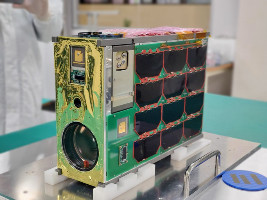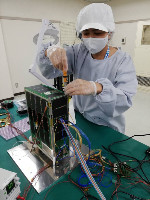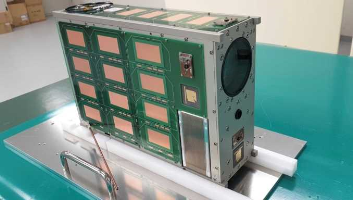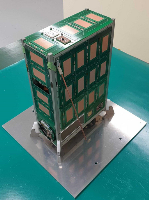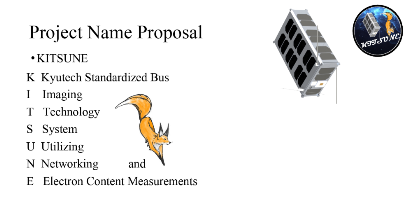| Satellite name |
KITSUNE (Kyutech standardized bus Imaging Technology System Utilizing Networking and Electron content measurements) |
| Spacecraft type |
CubeSat |
| Units or mass |
6U |
| Mass in kg |
7.268 kg |
| Status |
Reentry 2023-03-14. Was operational? (It was at least operational in July 2022 as per IAC 2023 paper) |
| Launched |
2022-02-19 |
| NORAD ID |
52148 |
| Deployer |
J-SSOD (JEM Small Satellite Orbital Deployer) |
| Launcher |
Antares (NG-17) |
| Deployment |
Deployed from ISS on 2022-03-24 |
| Organisation |
Kyushu Institute of Technology |
| Institution |
University |
| Entity |
Academic / Education |
| Country |
Japan |
| Launch brokerer |
Mitsui |
| Oneliner |
Imaging mission, Kyutech Standardized Bus, IoT and Total electron content (TEC) measurement mission.
|
| Description |
- High resolution camera mission The camera payload onboard KITSUNE satellite will capture 5 meter-class resolution images. KITSUNE satellite will use attitude determination and control system to aim the camera payload to capture 5 images around a target. During the next pass, by UHF uplink command, images will be downlinked over C-band communication. If C-band communication fails, UHF downlink will be used for images as well as telemetry.
- C-band communication demonstration mission The C-band communication board on KITSUNE satellite will demonstrate up to 20Mbps amateur high-speed data downlink.
- C-band mobile ground station mission A C-band mobile ground station is being developed as an independent system from the main ground station. Mobile ground station will uplink a command to the small 2-megapixel camera onboard the satellite to take 2 megapixel compressed images and downlink immediately. The objective is to demonstrate downlink speed up to 1Mbps over C-band to the mobile ground station. The mobile ground station will use the same frequencies as the main ground station.
- Total Electron Content Measurement Mission (mission without amateur link involvement) KITSUNE satellite carries a chip-scale atomic clock. It will be used to detect the time delay between uplink command sent from the ground station and receiving time on the satellite side. The ground station will send dummy data over 450MHz spread-spectrum signal, and it will record the time of the signal transmission at the ground station. KITSUNE satellite will receive this signal over software defined radio (SDR) and record the receiving time by using GPS time and chip-scale atomic clock. Recorded transmission times will be sent over 450 MHz UHF communication uplink. The time difference will be used to calculate total electron content of ionosphere onboard. UHF non-amateur downlink (400.960 MHz ) will be used to downlink the scientific data and telemetry.
- Store and Forward Mission (IoT Mission) (mission without amateur link involvement) KITSUNE satellite has a LORA device onboard as a receiver. There will be fixed and mobile ground sensor terminals with LORA devices.
- Earth observation with 5-m class resolution color images by COTS camera
- Development of 2U size Kyutech standard bus system
- Space Precision Atomic-clock TIming Utility Mission (SPATIUM)-2 for total electron content measurements in ionosphere
- Demonstration of LORA module
- Store and Forward from the sensor terminals of BIRDS countries
- Demonstrate C-band communication from the main and mobile ground stations
- Downlink of low-resolution images from a secondary camera by C-band uplink commands
|
| Sources |
[1] [2] [3] [4] [5] |
| Photo sources |
[1] [2] [3] [4] [5] |
| COTS subsystems |
|
| Subsystems sources |
[1] |
| On the same launch |
|
Last modified: 2024-12-29
